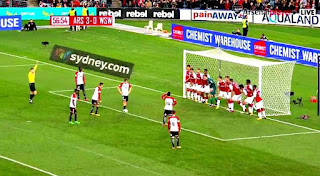An indirect free kick is a method of restarting play in a game of association football that is awarded to a team following most types of technical infringements of the Laws of the Game. In an indirect free kick, the non-offending team is entitled to freely kick the ball from the ground at the spot of the infringement (or from the spot where the ball was when play was stopped), with opponents required to be at least 10 yards (9.1 m) from the ball. The kicking team may not score a goal directly from an indirect free kick; the ball must first touch another player of either team in order for a goal to be scored. If the ball enters the goal directly from an indirect free kick, a goal kick is awarded to the opponent, unless it enters the kicker's own goal, in which case a corner kick is awarded.
Unlike a direct free kick, an offence punishable by an indirect free kick does not result in a penalty kick when it occurs in the offending team's penalty area; rather, it continues to be taken as an indirect free kick.
The law was derived from the Sheffield Rules that stated that no goal could be scored from a free kick. This law was absorbed into the Laws of the Game in 1877 and later adapted to allow indirect free kicks as a result of dangerous play. Today it is most commonly awarded for an offside offence.
Video Indirect free kick
Procedure
The kick is taken from where the infringement occurred, unless the offence was committed within the goal area of the team awarded the kick, in which case the kick may be taken from anywhere within the goal area. An indirect free kick within the opposing team's goal area is taken from the goal area line, parallel to the goal line, nearest to where the infringement occurred (i.e. at least 6 yards from the goal line).
The ball must be stationary prior to being kicked. Opponents must remain 10 yards (9.15m) from the ball (and also outside of the penalty area if the kick is taken from within the kicking team's penalty area) until the ball is in play. The exception to this is that opponents may be within 10 yards of the ball provided they are standing on their goal line between the goal posts.
The ball becomes in play when it has been kicked and moves, unless the kick was taken from within the kicking team's penalty area, in which case it is in play once it has passed completely out of the penalty area.
A goal may not be scored directly from an indirect free kick, rather it must be touched by a second player before a goal can be scored. If the ball goes in goal directly from an indirect free kick, a goal kick is awarded to the defending team. As with all restarts of play, if the ball goes directly into the kicker's own goal from an indirect free kick a corner kick is awarded to the opposing team.
The referee indicates an indirect free kick by raising his arm above his head until the kick has been taken and ball has touched another player other than the kicker or has gone out of play.
Maps Indirect free kick
Infringements and sanctions
Kicks are retaken if an opponent is closer to the spot from where the kick is taken than the required distance. Also, for a kick taken by a team inside their own penalty area, the ball is not considered in play until it has left the area. If the ball fails to travel directly out of the penalty area the kick is retaken.
The kicker will concede an indirect free kick to their opponents if they touch the ball again before another player (of either team) has touched it. If this second touch is an illegal handling of the ball offense, this takes priority and is penalised (with a direct free kick or penalty) accordingly.
See also
- Direct free kick
- Referee (association football)
References
External links
- Law 13 - Free Kicks FIFA
Source of the article : Wikipedia

